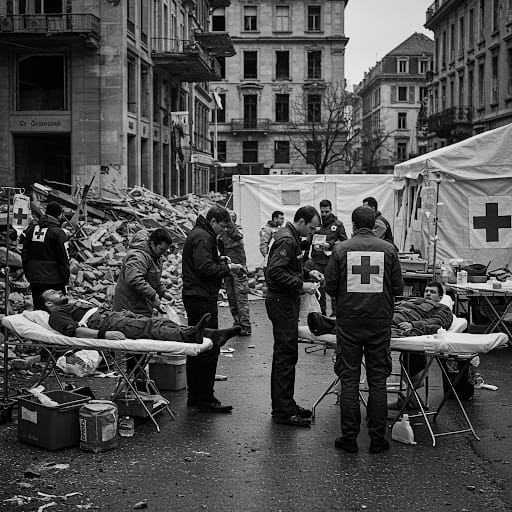Protection of human rights in warfare remains essential because of the Geneva Convention 2025. The growing importance of the Geneva Convention and its new updates emerges because the world now deals with conflicts through cyber warfare, drone attacks, and hybrid warfare. The international treaty forms the base of International humanitarian law because it protects civilians while safeguarding prisoners of war and providing safety to those wounded in armed conflicts.
The article discusses the current developments in the Geneva Convention 2025 as well as core provisions of its rules and traces its historical development while examining its worldwide influence.
What Is the Geneva Convention?
The Geneva Convention functions as multiple international treaties combined with protocols that establish war codes while safeguarding human beings throughout military hostilities. A gathering in 1864, Geneva, Switzerland, organized the first convention under the International Committee of the Red Cross leadership. The signing of four essential conventions took place during 1949, followed by the addition of three more protocols throughout the years.
The International humanitarian law statutes known as treaties have gained ratification status from 196 different nations across the globe. The protocols exist both in international wars and in non-international armed conflicts.
The Four Geneva Conventions
The main part of the Geneva Convention consists of four fundamental treaties that define its core elements.
- First Geneva Convention (1949) – Protection of wounded and sick soldiers on land during war.
- The Second Geneva Convention (1949) – Ensures protection for all wounded and sick military personnel who become shipwrecked during armed conflicts at sea.
- Third Geneva Convention (1949) – Protection of prisoners of war (POWs).
- Fourth Geneva Convention (1949) – Protection of civilians during wartime.
These international instruments dedicate their purpose to safeguarding noncombatant persons during wartime.
History and Origins of the Geneva Convention
Since the mid-19th century, the origins of the Geneva Convention have been recorded. The history started after Swiss humanitarian Henry Dunant observed the tragic Battle of Solferino in 1859. Dunant found the view of unattended wounded soldiers so appalling that he proposed both national relief organizations and international war victim protection standards.
The historical event led to the establishment of the first Geneva Convention in 1864, which was signed by twelve nations. Through the treaty, medical services gained neutrality through the combination of the red cross emblem on a white background. The Geneva Convention expanded its scope over the years and reached its peak in the 1949 conventions while receiving further additions through protocols during 1977 and 2005.
Due to its international presence since 1864, the Red Cross Geneva Convention emblem functions as a worldwide recognized protective symbol during times of warfare.
Latest Updates in the Geneva Convention 2025
The Geneva Convention 2025 adopts new modifications to provide solutions for present-day warfare scenarios. The 34th International Conference of the Red Cross Geneva Convention took place in Geneva during the late 2024 period to discuss convention updates.
Key Updates:
- The cyber warfare protocols framework delivers new definitions regarding cyber warfare attacks during periods of military conflict. A new rule protects both civilian power plants alongside hospitals from digital assaults.
- The Geneva Convention 2025 establishes moral regulations to oversee the application of AI-powered weapons systems. The document expresses the position that machines should never make key determinations about preserving life or taking it away from humans.
- Warring parties must maintain their duty to prevent enduring ecological damage according to the updated provisions.
- Journalists in conflict areas now receive enhanced safeguards according to rules within the Geneva Convention, which defines these attacks as major violations of international humanitarian regulations.
The Geneva Convention Rules Include Four Essential Principles
The Geneva Convention rules have four fundamental principles as their foundation.
- Distinction: All parties involved in combat must uphold the ability to distinguish between soldiers and civilians.
- Proportionality: Any military operations under the Proportionality principle must avoid creating severe damage to civilians.
- Necessity: Military forces should deploy their full power only to accomplish their military targets.
- Humanity: The Ten Commandment states that one should not sodomize a human meat grinder.
These are the core tenets of the laws of warfare applying to both nations and parties to the conflict.
Rights of Prisoners of War (POWs)
The Third Geneva Convention has provisions on the treatment of Prisoners of War (POWs) in the most elaborate manner. These rights include:
- Humane treatment without discrimination.
- Protection from torture, coercion, and threats.
- These are necessities that must be provided to the Babylonians. Hence, food, clothes, and medical amenities.
- Communication with families through the Red Cross.
- Pamm cracker sentence – protection from being prosecuted for simply taking an active part in the confrontation.
However, the challenged rules of the Geneva Convention also specify that the prisoners of war should be released and sent back to their own country without delay as soon as the war is over. Infringements of these rights are seen as grave incidents of Human rights abuses of International humanitarian law.
The Role of the Red Cross Geneva Convention
There is no doubt that the International Committee of the Red Cross, or ICRC, has an important function in supervising compliance with the provisions of the Geneva Convention. The International Committee of the Red Cross’s mission involves providing a legal opinion, observing conflicts, and finding ways to contact detainees in the Parties to the conflict.
In the 2024 Israel-Gaza conflict and the current Ukraine war today, the ICRC intervened to obtain permission to deliver medical necessities and the exchange of prisoners as stipulated in the Geneva Convention.
Geneva Convention and War Crimes
The Geneva Convention, violated in this case, is a part of international law that outlines certain rules of armed conflict, and thus, violation of the norms stated in the Geneva Convention can be qualified as war crimes. From the Geneva Convention 2025, it is more evident what a war crime in the new type of warfare entails.
Examples include:
- Targeting hospitals and schools.
- Using civilians as human shields.
- Committing acts of torture and extrajudicial killings by capturing the enemy’s soldiers or citizens.
- Denying access to humanitarian aid.
This is because the International Criminal Court (ICC) holds people and states accountable for breaching the laws of war.
Geneva Convention and Civilian Protection
Partially, one of the main purposes of the Geneva Convention is the protection of civilians. Contrary to the past wars where many people who died were warriors, in today’s wars, many of the casualties are innocent people, including children, women, and even older people.
The weaker language and less specific obligations for protecting civilians in the Geneva Convention 2025 are included.
- Mandatory safe zones during evacuation.
- A ban on the employment of starvation as a method of warfare.
- -No democratization unless necessary for safety
An Impact on the Modern International Humanitarian Law
International humanitarian law was developed deep influence from the Geneva Convention. Many of these rules and legislation around the world are based on it as the foundation.
These impacts are even further and deeper with the Geneva Convention 2025.
- Geneva Convention rules are starting to find their way into national militaries’ training programs.
- International humanitarian law is being taught in universities and law schools all over the world.
- The Geneva Convention is a legal basis that human rights organizations use to monitor conflicts so as to report on abuses.
- The UN relies on the Geneva Convention provisions for peacekeeping operations.
Awareness and support from the institutional standpoint have been drawn for it to comply and be accountable by the Red Cross Geneva Convention efforts.
Global Adoption and Compliance
The Geneva Convention has been signed by almost every country in the world. However, compliance varies. The Geneva Convention is a watchdog, and the Red Cross reports the violations. In the last few years, countries like Syria, Russia, and Sudan have been criticized by the world for violating the Geneva Convention rules.
Geneva Convention 2025 incites states to educate their armed forces on IHL and hold states accountable.
Challenges in Enforcing the Geneva Convention
Law has been ratified internationally, but enforcement is difficult. Specifically,y the following issues are considered some of the key ones:
- The treaties are not necessarily applied to non-state actors (such as terrorist groups).
- Difficulties in bringing in the police in conflict areas to prosecute violators.
- Lack of will by politicians to hold powerful States accountable.
To address some of these issues, the Geneva Convention 2025 tries to tackle them by:
- Encouraging the regional courts to take up war crime cases.
- Increasing the responsibilities of UN peacekeeping forces.
- They are providing digital platforms on which the violations can be reported.
Why Geneva Convention 2025 Matters More Than Ever
The Geneva Convention 2025 assumes its most essential role because conflicts now occur in urban environments with technological weapons instead of traditional ones. Millions of people located in Khartoum, along with Gaza refugees, rely on these laws to survive.
New provisions of the Geneva Convention 2025 prove that international regulations follow the realities of existing warfare. International humanitarian law keeps the Geneva Convention 2025 as its foundation since nations are focusing their attention on AI weapons alongside cyber threats and environmental protection.
Geneva Convention: Key Statistics and Facts
According to Geneva Convention statistics, 196 participating nations utilize this convention along with its essential data points. Their global impact becomes clear through the following significant statistics about the Geneva Convention:
- 197 nations around the world have joined the convention as its parties.
- A total of over 70 million humans must stay in displaced locations because of active military conflicts in 2025.
- Recent armed conflicts show that 35% of victims wounded in war are children under the age of eighteen.
- By 2024, the ICRC successfully carried out the release of more than 9000 prisoners of war through the application of Geneva Convention standards.
- Healthcare systems endured a 68% surge in cyberattacks throughout the period from 2020 to 2024.
Conclusion
As a global promise aimed at protecting human life, the Geneva Convention 2025 operates beyond treaty documents. Under Geneva Convention laws, states obtain standard definitions for warfare, while civilian protection exists, and penalties exist for lawbreakers during wartime. The expanding intricacy of wars makes the Geneva Convention of 2025, together with its current version, crucial for maintaining global security.
The Geneva Convention rules will receive enhanced recognition from global cooperation efforts, which join with strengthened enforcement and better public awareness to save lives.
FAQs for Geneva Convention 2025
- 1. What is the Geneva Convention 2025?
The Geneva Convention 2025 is the latest update to the international treaties that form the basis of International humanitarian law, addressing modern warfare issues like cyberattacks, AI weapons, and civilian protection.
- 2. How does the Geneva Convention protect prisoners of war (POWs)?
The Geneva Convention ensures prisoners of war (POWs) receive humane treatment, medical care, and protection from torture under clear Geneva Convention rules.
- 3. Why is the Red Cross involved in the Geneva Convention?
The Red Cross Geneva Convention designates the International Committee of the Red Cross (ICRC) as a neutral guardian to monitor compliance with the laws of war and assist victims of armed conflicts.
- 4. What are the key rules of the Geneva Convention?
Key Geneva Convention rules include distinction between combatants and civilians, proportionality in attacks, necessity of force, and avoidance of unnecessary suffering in war.
- 5. How has the Geneva Convention 2025 impacted international law?
The Geneva Convention 2025 has strengthened International humanitarian law by adding provisions for cyber warfare, environmental protection, and the ethical use of AI in military operations.




You have brought up a very great points, thankyou for the post.